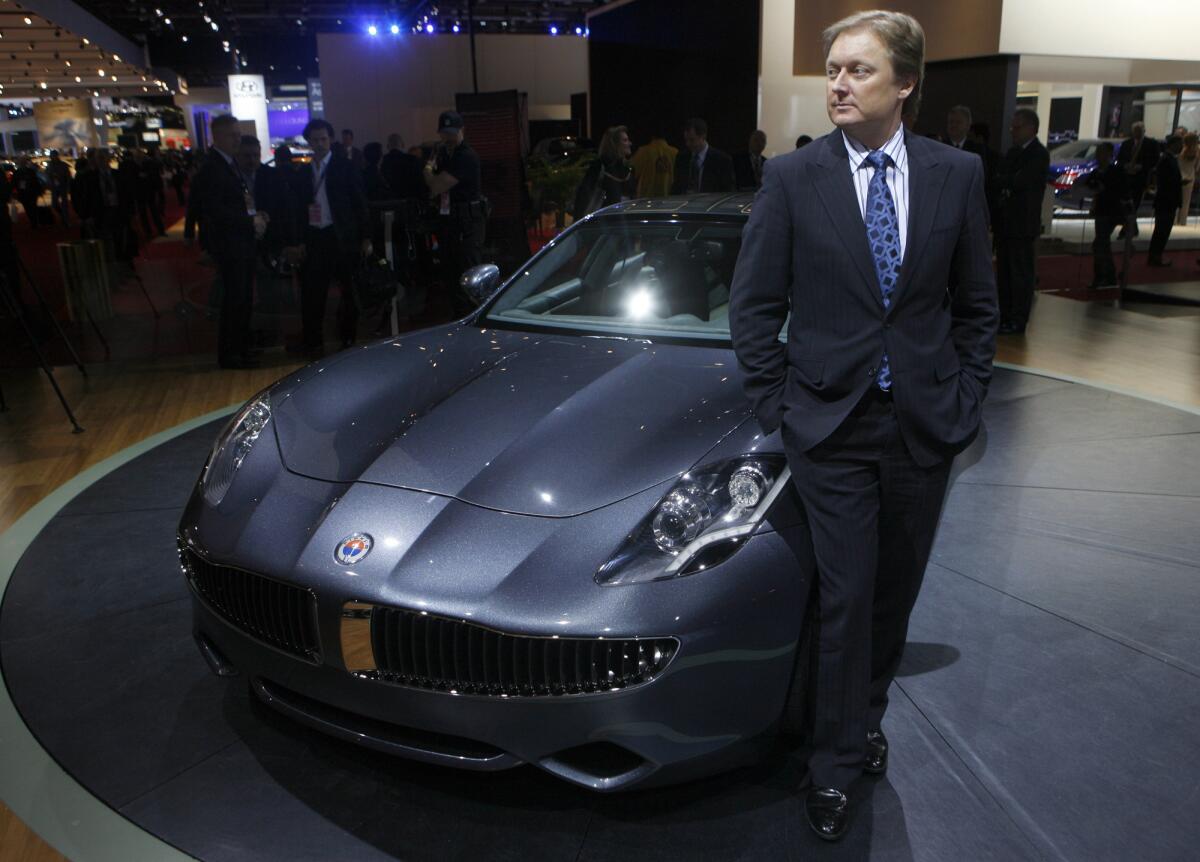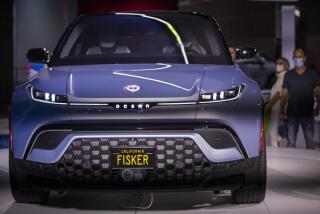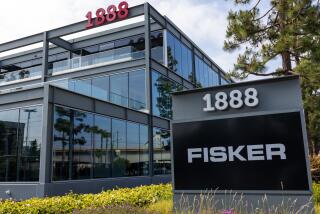From the Archives: Henrik Fisker: Moving, rapidly, into the future

Henrik Fisker, at the 2009 Detroit auto show, quit as executive chairman of Fisker Automotive amid a dispute with management.
- Share via
Not long ago, Henrik Fisker was dashing up Interstate 5 to San Francisco when a highway patrolman clocked his Aston Martin roadster -- a car that Fisker himself designed -- going 97 mph.
He protested. (“It was 90 at the most.”) He got a ticket and set the cruise control at 70. For the next four hours, “I was overtaken by every grandmother,” he said. Running late, he pressed down the pedal.
This time, the radar gun caught him going 88 mph.
“How long since your last ticket?” the officer asked. Fisker paused, but decided to fess up. “Well, actually, not that long ago,” he replied.
Over the last two decades, Fisker has designed some of the sexiest cars on the road: sleek BMWs and Aston Martins that accelerate from 0 to 60 in the time it takes to count the fingers on one hand.
Now the Danish designer has his own Irvine-based car company and a half-billion-dollar loan from the U.S. government to build gas-electric hybrid cars that plug into a home outlet, go 50 miles without a drop of gas and don’t look a bit eco-friendly.
Oh, and they’ll also be fast.
“People feel very emotional about cars, and I don’t want them to feel bad about driving a fast car,” said Fisker, as he steered his growling roadster through rush-hour traffic on Sunset Boulevard. “We’re building beautiful and fast cars that you can drive without having a bad conscience or ruining the environment.”
Many auto industry analysts are skeptical. History is scattered with the wreckage of car companies started by big dreamers, Preston Tucker and John DeLorean among them. Building eco-friendly cars, even eco-chic cars, is one thing, analysts say. Selling them to a fickle public, with pump prices below $3 a gallon, is another.
But Fisker, one of the world’s most highly regarded designers of luxury automobiles, likes his chances. And he’s a focus group of one.
“As a car lover, I ask myself: What am I going to be buying in the future?” he said. “Will it be a boring, underpowered, dorky car because the government tells me I shouldn’t pollute? Or do I come up with a cool-looking, sexy dream car that is also part of the future?”
Tall and fit, tanned and blond, Fisker, 46, is a dream front-man for a car maker, with a resume that few designers can match. He is best known for designing the BMW Z8 and the Aston Martin DB9 and V8 Vantage, vehicles with six-figure sticker prices and ageless silhouettes.
An automobile is one of the most complex products for a designer, who must create an aesthetic that combines elements of proportion, sculpture and graphics while accommodating thousands of parts and teams of engineers and marketers.
Fisker is known for designs that are fresh as well as classic. “He can do something new and contemporary -- but do it with an echo of the brand legacy,” said Stewart Reed, chairman of the transportation design department at the Art Center College of Design. “He understands the importance of proportion and architecture. But he also understands that design, at the end of the day, is a business tool.”
The Z8 roadster, a $128,000 update of the 1956 BMW 507, reflects Fisker’s classical design sensibilities, with long, sweeping hood lines and a bold curve over the wheels, which is one of his signatures. The result is a car with a powerful stance, an unmistakable BMW pedigree and, as many reviewers put it, a “timeless design.”
James Bond drives a silver Z8 in the 1999 film “The World is Not Enough.” Bond survives in the movie; the car doesn’t. It is sawed in half.
Walking around his Aston Martin V8 Vantage recently, Fisker pointed out the design elements he used in the $150,000 vehicle. The long, sleek lines are “a human-like form of sculpture that I think makes a car sexy,” he said. “It’s like a muscle, with the veins of the muscle shining through.”
The Vantage has a rounded shoulder over the wheels, giving it a muscular bearing.
“I like to have the widest part of the car being the wheels and not the body,” he said. “It gives it a more athletic look and, with the sculpture, helps make a car look sexy.”
For Fisker, raw, curbside appeal is the key to car design.
“You’ve got to capture the emotional part through the form, so that when people look at it, even before they know if it’s a good-quality car or a fast car, even if they aren’t a ‘car person,’ they say, ‘Wow, I’ve got to have that.’
“When I see a car I’ve designed going down the street and somebody admiring it, that’s a nice feeling,” he said.
The story of how Fisker became a heralded car designer and the eponymous head of what he likes to call “a new American car company” began in Denmark, a country with no automobile manufacturing industry. He had his first inkling that he might one day design cars at age 5, when he was riding in his father’s Saab near their home in suburban Copenhagen. A Maserati raced past.
“I got butterflies in my stomach,” Fisker said. “It was then that I knew I had to do something with the way cars look.”
He began drawing cars for fun and continued long after boys his age outgrew the phase. His teachers discouraged his ambitions; Denmark, after all, had no jobs for car designers.
But Fisker’s father, an electrical engineer who had visited the United States as a teenager, encouraged him.
“America had inspired him to believe that you can do whatever you want in life, and that’s what he always told me,” Fisker said. “That was not a typical thing to say to your kids in Denmark.”
Fisker eventually lugged his portfolio to Switzerland, where he studied at the European campus of the Pasadena-based Art Center College of Design. After graduating, he went to work at BMW’s advanced design studio and later became president of its subsidiary, Designworks/USA, in Ventura County.
In 2001, Fisker moved to Ford Motor Co., first as creative director of its design center in London and then as head of the design studio in Irvine. Later, he was design director, and member of the board, at Aston Martin, the ultra-premium carmaker Ford owned at the time.
Two years ago, Fisker and Bernhard Koehler, a German car executive who had worked with Fisker at BMW and Ford, launched Fisker Automotive. The Department of Energy awarded it a $528.7-million loan in September to build two cars, part of a $25-billion effort to jump-start a green revolution in the industry.
The first car built will be the Karma, an $87,900 plug-in hybrid sedan with solar panels that will run the climate-control system, keeping the car cool when the vehicle is shut off. The Karma will be assembled in Finland, with a majority of American parts, and production will start late next year, with a target of 15,000 vehicles annually.
The majority of the federal money, though, will go to Fisker’s next-generation vehicle, code-named Project Nina, a “family oriented” plug-in hybrid sedan that will cost $47,400 (less a $7,500 federal tax credit). The Nina will be built beginning in 2012 at a former GM plant in Delaware, with an annual target of 100,000 vehicles a year.
“A lot of cars have a stylish and sexy sculpture,” Fisker said, but the Nina “will definitely be the most radical, sexy family car on the planet.”
Fisker Automotive, with about 75 employees, is headquartered in an office park in Irvine and has an engineering facility in Pontiac, Mich. So far, 45 dealers nationwide have signed up to sell Fisker automobiles, and more than 1,600 people, including former Vice President Al Gore, have placed orders for the Karma.
The design of Fisker’s Nina remains under wraps at company headquarters, where fingerprint identification is required to access the design rooms. But Fisker executives say it will be as dramatic as the four-door Karma, which is on display at the Los Angeles Auto Show.
In designing the Karma, Fisker said, he was mostly focused on what it wouldn’t look like: an eco-friendly car. The result is a vehicle with Fisker’s characteristic long lines, rounded shoulders over the wheels and, in a radical move for Fisker, a front grille that resembles a smile. The design has won admiring reviews, though Fisker says he’s happy if it doesn’t appeal to everyone.
“We’re not making cars for everyone,” he said. “I want to have some character in the car. I don’t want a design that is a milk doughnut.”
Milk doughnut?
“Oh, what’s the word in English? Milquetoast. That’s what I mean.”
Both the Karma and Nina will go 50 miles on an eight-hour charge from a 110-volt outlet. After that, a gasoline engine will kick in to generate electricity, adding 250 miles to the range. When using both electricity and gas, the cars will average about 100 miles per gallon, the company says.
Fisker noted that the average American commute is less than 30 miles round-trip, and 80% of motorists drive fewer than 40 miles a day. On longer trips where electrical outlets are not available, the Karma and Nina can be driven on gasoline alone, eliminating what designers call “range anxiety” and providing an advantage over all-electric vehicles.
As for speed, the 400-horsepower Karma will go from 0 to 60 in about six seconds, almost as quickly as the V8 Vantage, with a top speed of 125 mph. “Our cars will say, ‘I care. But I also enjoy life,’ ” Fisker said.
He will have plenty of competition -- from all-electric vehicles made by Tesla Motors, another California recipient of a large federal loan, as well as other companies with hybrids in development.
“There’s a lot of good with this company, and the Karma is absolutely stunning,” said Rebecca Lindland, an auto analyst with IHS Global Insight. “But the risk is huge. They’re as likely as a Hollywood starlet to make it. Some do and others don’t. What separates the two is often luck.”
Either way, she said with a touch of admiration, “you have to have a lot of self-confidence and a lot of charisma to start up an auto company.”
Fisker feels especially at home in California, “a place where people still love cars,” he said.
He lives with his wife and two teenage children in Newport Beach and commutes to work in the 2009 V8 Vantage, which he leases. (“People think they give you these cars when you design them, but they don’t,” he said.) By this time next year, he’ll be making the drive in a Karma.
He still finds time to draw new ideas for cars: in hotels, at his desk at home or on the drafting table in his office.
“Sometimes I’ll be taking in some sun by my pool and, suddenly, I’ll have a good idea,” he said. “I go in and get a piece of paper and make a little sketch.”
He particularly relishes his time behind the wheel, where he keeps the radar detector on and the cellphone off.
“A car is one of the last things in our civilized society where we can still control amazing power,” he said. “If the car were invented today, it wouldn’t be legal.”
He fondly recalls one day in Germany when he was driving to work on the Autobahn around 5 a.m. He looked up at the speedometer and was surprised to see that he was going 196 mph. “That’s why you can’t use cup holders in Germany,” he said.
“My palms were a bit sweaty. It was pretty cool.”
--
FROM THE ARCHIVES:
DiCaprio, Bieber caught up in Fisker Karma hybrid recall
U.S. taxpayers could wind up with Fisker Automotive assets
As potential investors back away, Fisker retains bankruptcy law firm
Management fight pushes Henrik Fisker from car company he founded
Plug-in hybrid maker Fisker Automotive gets $529 million from Obama administration







